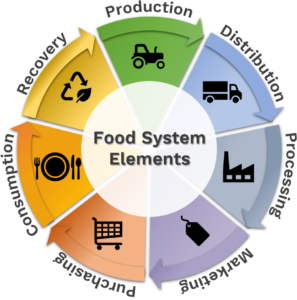Food Security and Food Systems
What is food security?
“Food security exists when all people, at all times, have physical and economic access to sufficient, safe and nutritious food that meets their dietary needs and food preferences for an active and healthy life”
World Food Summit, 1996
But what does that mean? In the video below, Prof. Dr. Andy Nelson from the International Institute for Geo-Information Science and Earth Observation, University of Twente (ITC/UTwente), gives an overview of food security and food systems.
The term food security was institutionalized in the 1970s and evolved over time. Find out about the development of the food security concept below.
Source: FAO, 1983; Sen, 1981; Shakeel, 2018; Stevens et al., 2000; United Nations (UN), 2016; United Nations (UN), 2015; World Bank, 1986. Photo by Pixabay
Dimensions of food security
For food security objectives to be realized, all four dimensions must be fulfilled simultaneously. This means, if food is available, accessible, and useable, and if all of these are stable, then food security is achieved. If any one of these is not met, then the result is food insecurity (FAO, 2008).
Aspects of food insecurity
Let’s now take a look at the aspects of food insecurity. There are important differences in how the duration and severity of food insecurity impact people’s lives. Furthermore, it is essential to know how vulnerable people are and what are the risk factors. So, food insecurity is characterized by the aspects of duration, severity, and vulnerability of the affected people. (FAO, 2008, 2018a).
Food security measures
The appropriate measurement of food security is critical for planning food and economic aid; evaluating the status and monitoring the change to inform policymakers across many sectors. Most measures of food security are based on one or more of the four pillars of food security (availability, access, utilization, and the stability of food security over time) and draw from data at national, regional, household, and/or individual levels.
Measuring food security is complex. Indicators that measure selected aspects of food security are useful tools that help to simplify the task. Summarized into composite indicators and displayed on a map or dashboard, they allow us to quickly find out about and compare the food security status in different locations of the world. They also facilitate communication. However, when working with food security indicators, it is also important to bear in mind which indicators were selected, why, which input data was used, and which model was applied to calculate the composite indicator.
There is no consensus on which suite of indicators best reflects food security. And while a comprehensive indicator set may give a more complete picture of the food security status, it also means that a lot of input data is necessary that may not always be available everywhere in the world, at all administrative levels, and in the desired quality.
The table gives an overview of composite food security indexes, the number of input indicators, and the countries they are available for.
| Index | No. of indicators | No. of countries |
| Proteus Index (2020) | 21 | 185 |
| Ending Rural Hunger Index (2015) | 80 | 152 |
| Hunger Reduction Commitment Index (2014) | 9 | 21 |
| Hidden Hunger Index (2013) | 3 | 149 |
| Global Food Security Index (2012) | 58 | 113 |
| Food Insecurity Multidimensional Index (2011) | 20 | 61 |
| Hunger FREE Scorecard (2009) | 13 | 29 |
| Poverty and Hunger Index (2008) | 5 | 81 |
| Global Hunger Index (2006) | 4 | 119 |
| Food Security Index (1989) | 5 | 69 |
The Global Food Security Index (GFSI)
The Global Food Security Index (GFSI), designed and constructed by Economist Impact, considers a set of indicators of food affordability, availability, quality and safety, and natural resources and resilience across a set of 113 countries.
See the map below to compare the food security of different countries according to the GFSI.
Click on the map to open the site with the interactive map, where you can investigate the Overall, Affordability, Availability, Quality and Safety, Sustainability, and Adaptation indices per country.
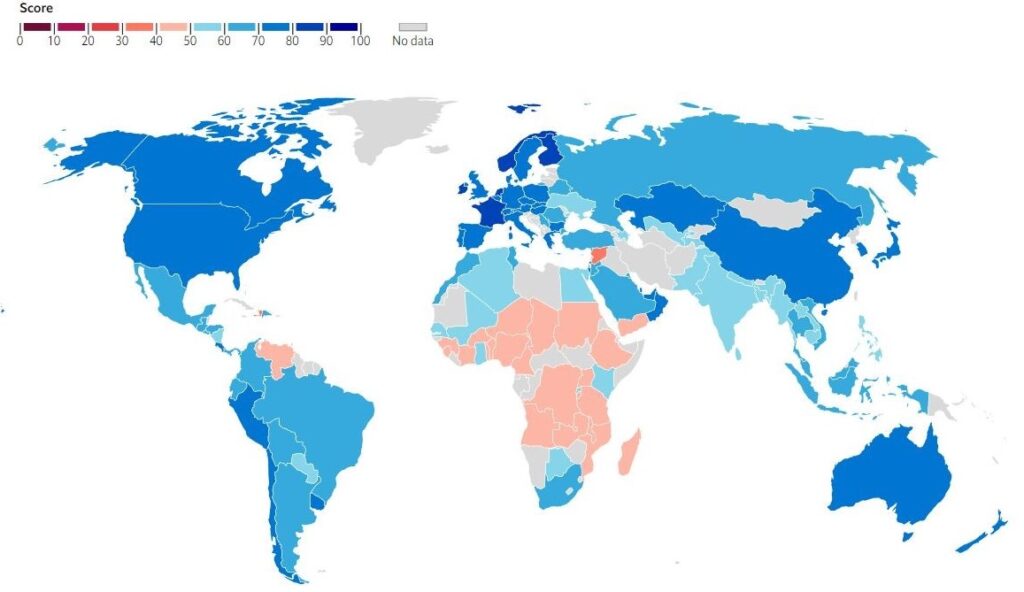
The Proteus Index
Another take on measuring food security is the Proteus Index operationalizes the dimensions of food security through 21 indicators, e.g. (indicator no.),
- Availability – Average dietary energy supply adequacy (%) (3-year average) (1)
- Access – GDP, PPP (constant 2011 international $), per capita (7)
- Utilization – People using at least basic sanitation services (% of the population) (10)
- Stability – Damage from disasters in US$ (10-year weighted), the share of GDP (21)
The input data is sourced from a range of comprehensive global databases, such as the Food and Agriculture Organization of the United Nations (FAO) data archive or the Emergency Event Database (EM-DAT) (Caccavale & Giuffrida, 2020).
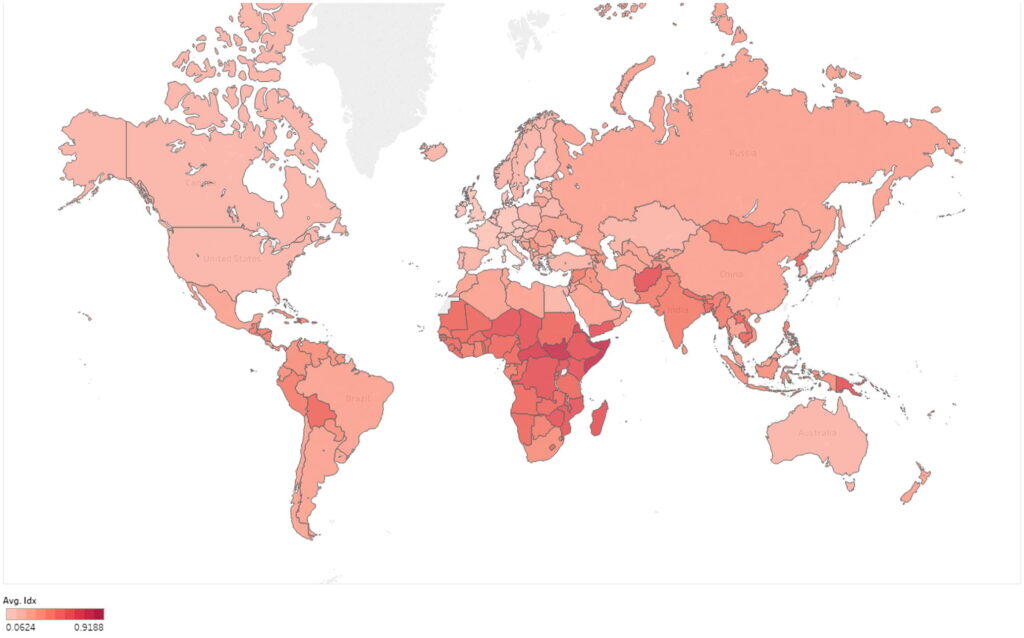
Click on the map to enlarge it.
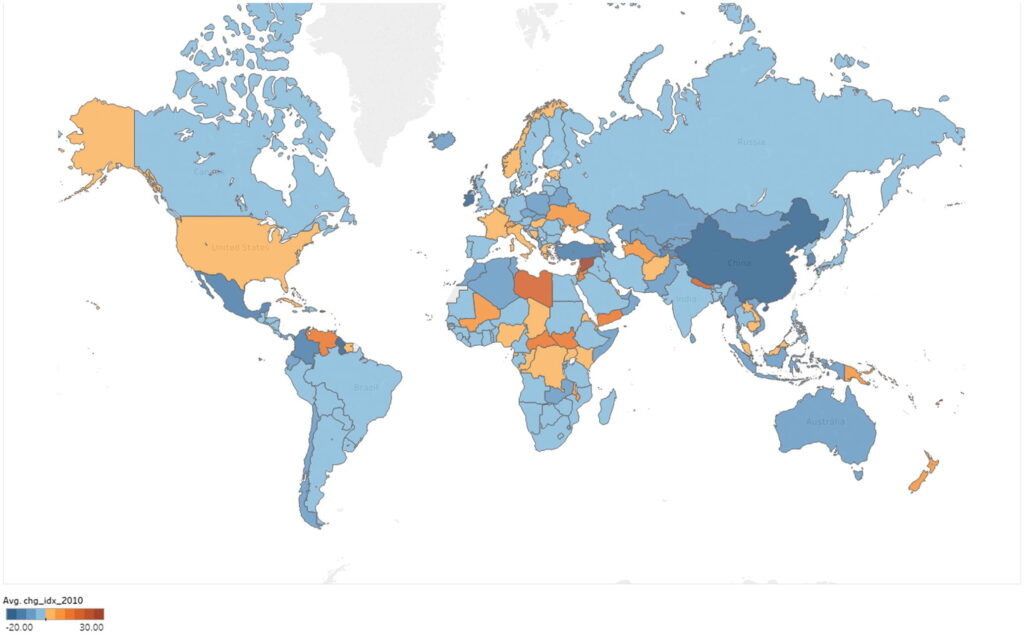
The World Food Programme (WFP) Hunger Map LIVE
One example of a food security dashboard is the World Food Programme’s Hunger Map. It is a near-real-time monitoring system of global food security and is based on regular telephone interviews of randomly selected households on administrative level 1. The survey includes questions on household demographics, households’ food consumption, coping strategies used (food-based and livelihood-based), access to food, market and health services, and other country-specific livelihood-related questions. Where insufficient survey data is available, Proteus composite index information is used in a predictive model to achieve global coverage.
Explore the WFP Hunger Map below! Click on your countries of interest to view their state of food security, nutrition, food security trends, as well as some economic indicators!
Food systems
Food systems (FS) encompass the entire range of actors and their interlinked value-adding activities involved in the production, aggregation, processing, distribution, consumption, and disposal of food products that originate from agriculture, forestry or fisheries, and parts of the broader economic, societal and natural environments in which they are embedded.
The food system is composed of sub-systems (e.g., farming system, waste management system, input supply system, etc.) and interacts with other key systems (e.g., energy system, trade system, health system, etc.). Therefore, a structural change in the food system might originate from a change in another system; for example, a policy promoting more biofuel in the energy system will have a significant impact on the food system (FAO, 2018b).
Definitions: food along the food supply chain
Food production: Food at the point when crops are ready for harvest, livestock ready for slaughter, and fish caught. This is food at the start of the production stage of the food supply chain.
Food production practices: Three main categories of food production practices are:
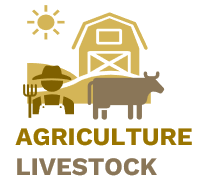
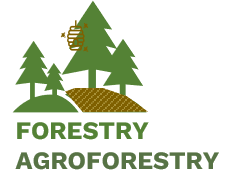
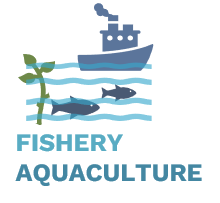
Food availability: Food at the point when it is ready to eat but not yet ingested. This includes food available for retail purchase and in restaurants.
Food consumption: Food ingested by people. This number is lower than “food availability” because it subtracts consumer waste, that is, food that is not ultimately eaten.
Food supply chain: The movement of food from farm, ranch, or boat to the consumer. The food supply chain consists of five stages: production—during or immediately after harvest or slaughter; handling and storage—after leaving the farm for handling, storage, and transport; processing and packaging—during industrial or domestic processing and/or packaging; distribution and market—during distribution to wholesale and retail markets; and consumption—in the home or business of the consumer, in restaurants, or through caterers.
Food loss: The food lost from human consumption in the production, handling and storage, and processing part of the chain. Some of this food may be diverted to animal feed.
Food waste: The food that does not get consumed by people after it reaches the retail or consumption stage
[Source: https://www.wri.org/research/creating-sustainable-food-future]
Sustainable food systems
A sustainable food system (SFS) is a food system that delivers food security and nutrition for all in a way that the economic, social, and environmental bases to generate food security and nutrition for future generations are not compromised.
This means that:
- It is profitable throughout (economic sustainability)
- It has broad-based benefits for society (social sustainability); and
- It has a positive or neutral impact on the natural environment (environmental sustainability)(FAO, 2018b).
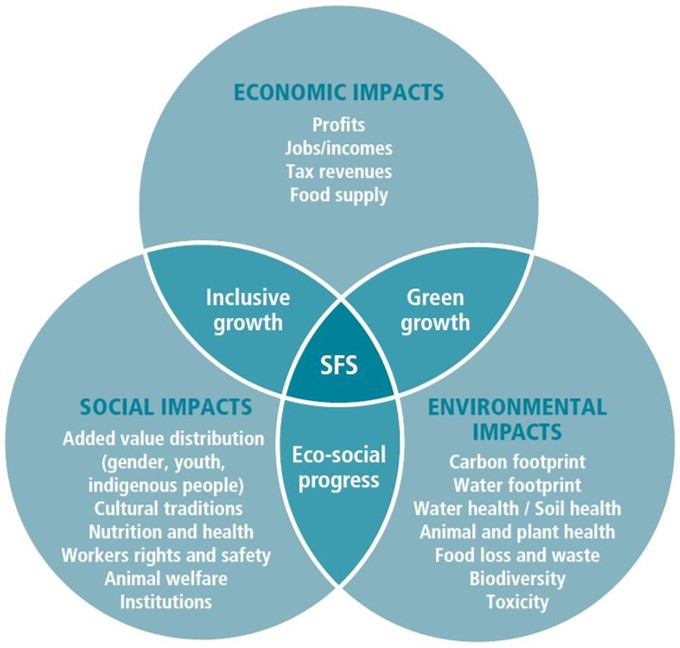
Sustainable food systems lie at the heart of the United Nations’ Sustainable Development Goals (SDGs). The SDGs call for major transformations in agriculture and food systems in order to end hunger, achieve food security, and improve nutrition by 2030.
To realize the SDGs, the global food system needs to be reshaped to be more productive, more inclusive of poor and marginalized populations, environmentally sustainable and resilient, and able to deliver healthy and nutritious diets to all. These are complex and systemic challenges that require a combination of interconnected actions at the local, national, regional, and global levels.
Traditional food security programs tend to adopt a production-focused approach, which seeks to directly influence food security through increasing the supply of food. However, the dramatic pace of food system changes over the past decades has brought about complex interactions and feedback loops that impact food security and nutrition in many different ways.
In sustainable food system development, sustainability is examined holistically. In order to be sustainable, the development of the food system needs to generate positive value along three dimensions simultaneously: economic, social, and environmental (FAO, 2018b).
Credit
This topic is created with the help of learning materials kindly provided by Prof. Dr. Andrew Nelson, International Institute for Geo-Information Science and Earth Observation (ITC), University of Twente.
Sources and further readings
Sources
Caccavale, O. M., & Giuffrida, V. (2020). The Proteus composite index: Towards a better metric for global food security. World Development, 126, 104709. https://doi.org/10.1016/j.worlddev.2019.104709
FAO. (1983). World Food Security: A Reappraisal of the Concepts and Approaches. Director Generals Report.
FAO. (2008). An Introduction to the Basic Concepts of Food Security. Food Security Information for Action: Practical Guides. EC – FAO Food Security Programm. https://www.fao.org/3/al936e/al936e00.pdf
FAO. (2018a). EC-FAO Food Security Information for Action Programme: Food Security Concepts and Frameworks- What is Food Security?
FAO. (2018b). Sustainable food system, Concept and framework. https://www.fao.org/3/ca2079en/CA2079EN.pdf
Sen, A. (1981). Poverty and Famines: An Essay on Entitlement and Deprivation. Clarendon Press.
Shakeel, A. (2018). ‘Food Security: Theorizing the Evolution and Involution of the Concept.’ 21(1), 26.
Stevens, C., Greenhill, R., Kennan, j, & Devereux, S. (2000). The WTO Agreement on Agriculture and Food Security. Commonwealth.
United Nations (UN). (2015). Transforming our World: The 2030 Agenda for Sustainable Development (A/RES/70/1). https://sdgs.un.org/2030agenda
United Nations (UN). (2016). United Nations Department of Economic and Social Affairs, The Millennium Development Goals Report 2015. https://doi.org/10.18356/6cd11401-en
World Bank. (1986). Poverty and Hunger: Issues and Options for Food Security in Developing Countries.
World Food Summit. (1996, November). Rome Declaration on World Food Security. https://www.fao.org/3/w3613e/w3613e00.htm
Further reading
Béné, C., Prager, S. D., Achicanoy, H. A. E., Toro, P. A., Lamotte, L., Bonilla, C., & Mapes, B. R. (2019) article in Scientific Data:
‚Global map and indicators of food system sustainability‘ https://doi.org/10.1038/s41597-019-0301-5
Charles, H., Godfray, J., BeddingtonIan, J. R., Crute, I. R., Haddad, L., Lawrence, D., Muir, J.F., Pretty, J. And Robinson, S. Article in Science: ‚Food Security: The Challenge of Feeding 9 Billion People‘ https://doi.org/10.1126/science.1185383
FAO Food Security reports:
– The state of food security and nutrition (SOFI)‘ https://www.fao.org/publications/sofi
– The state of food and agriculture (SOFA)‘ https://www.fao.org/publications/sofa
Jones, Andrew D., Ngure, F. M., Pelto, G., & Young, S. L. (2013). What Are We Assessing When We Measure Food Security? A Compendium and Review of Current Metrics. Advances in Nutrition, 4(5), 481–505. https://doi.org/10.3945/an.113.004119
Pérez-Escamilla, R. (2017). Food Security and the 2015–2030 Sustainable Development Goals: From Human to Planetary Health: Perspectives and Opinions. Current Developments in Nutrition, 1(7), 1–8. https://doi.org/10.3945/cdn.117.000513
Springmann, M., Clark, M., Mason-D’Croz, D., Wiebe, K., Bodirsky, B. L., Lassaletta, L., Vries, W. Vermeulen, S. J., Herrero, M., Carlson, K. M., Jonell, M., Troell, M., DeClerck, F., Gordon, L. J., Zurayk, R., Scarborough, P., Rayner, M., Loken, B. Fanzo, J., Godfray, H. C. J., Tilman, D., Rockström, J. & Willett, W. (2018) article in Nature:
‚Options for keeping the food system within environmental limits‘ https://www.nature.com/articles/s41586-018-0594-0
You covered the basics of food security, food security measures, food systems, and sustainable food systems.
Next, let’s learn how food is linked to climate, environment, society, and economy.
Complete the quiz below to advance to the next topic!
Discussion
-
Food Security and Food Systems
Sorry, there were no replies found.
Log in to reply.




